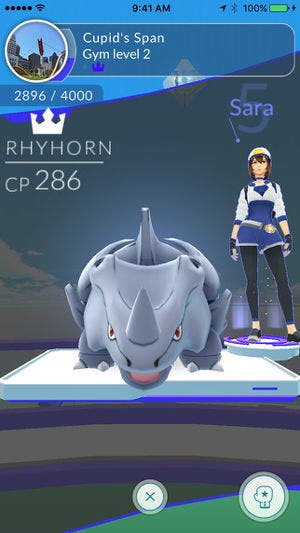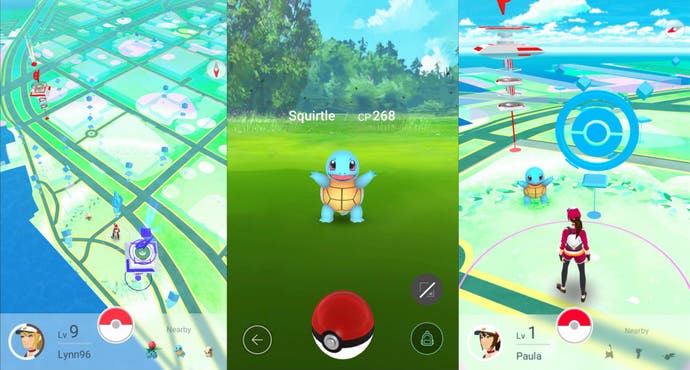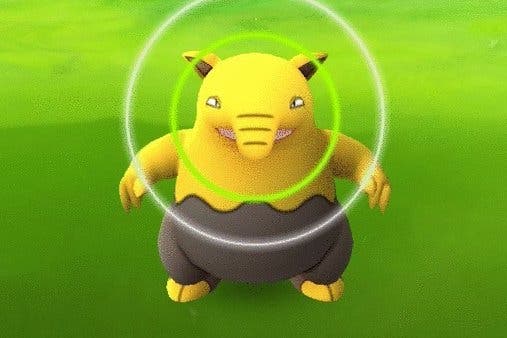I played Pok¨¦mon Go in Croydon
A wild Whitgift appeared!
The Pokémon Gym that stands ten minutes from where I live is an imposing beast: a wedge of purple-orange glass slicing through the Croydon skyline. Right now, it belongs to Team Yellow, which is great because that's who I've sworn fealty with, but also not so great because it is already fully staffed. Before I start trying to sort that out, I'll just grab my phone and trawl the high street for a better class of Pokémon. I've seen Dratini there. It's only a matter of time.
Since being tasked with giving Pokémon Go a weekend whirl, I've come to a conclusion: Pokémon Go is shallow. Like, really shallow. There is no real strategy to acquiring new Pokémon, and it's entirely possible to best player-inhabited Gyms by tapping very quickly. All of the depth of the games, all of the layers they've built across the history of a franchise - gone.
But at the same time Pokémon Go is also very, very, very, good.

If you break it down to a molecular level, the series has always been about the spirit of adventure, gallivanting across countrysides and cities, encountering new and foreign species of Pokémon. And that's what Pokémon Go is: a distillation of that sense of discovery. Rawboned and bug-riddled, sure. Plagued by flagging servers and a lack of access in certain countries, definitely. But still.
It is transposing the world of Pokémon onto our dimension, populating street corners and McDonalds with opportunities to snag a rare delight. It is turning trips to the Thames into a hunt for Gyarados and 3am excursions into a quest for Clefairies. It is making people talk. And there's something transcendently beautiful about that.
(Caveat: it also making the wrong people talk, notably armed criminals and hapless trainers. Please, guys. Be careful out there.)
But how does the game itself work? As alluded to earlier, it's pretty simple. You begin by customizing the colours - and gender - of your trainer, listening to some basic exposition, and then deciding on a starter Pokémon. Because Niantic Labs chose to go with the original 151 Pokémon, that means Bulbasaur, Charmander, and Squirtle. (Pikachu is actually available as a "secret" option, but you didn't hear that from me.)
Unlike with other Pokémon titles, you'll be required to catch your own starter here. Fortunately, it's not terribly difficult. In fact, it's not difficult at all. Netting a Pokémon involves nothing more than flicking a Pokeball in its direction. If your aim proves true, you'll clonk it on the head and be free to go on your way. If you fail, the Pokeball will bounce across a camera-eye view of whatever exists in front of your frontal camera. (Unless you turn augmented reality off, in which case, the sphere will roll along virtual grass.) Repeat until success is yours.
With rarer or more powerful Pokémon, it gets fractionally more complicated, demanding better Pokeballs and also the element of speed. Your quarry can and will escape, possibly to the detriment of your public image as you hiss complaints in the middle of a crowded train. There's also the whole thing with curveballs and good aim, with minor bonuses awarded for such miracles of manual dexterity, but that doesn't add much to the experience.

The gameplay becomes more interesting once you've hit level five, and you can choose a team and access the gyms. Distributed across the world at seemingly random, they're hotbeds of asynchronous competition. Any gym can be challenged at any time, and any team can steal one of these locations from another by defeating the resident Pokémon. To do that, you go up to a gym, select a Pokémon to challenge with, and leap into combat.
The fights themselves are rather rudimentary: swipe to avoid attacks, tap to launch attacks, and hold to unleash a special attack. After you've run the necessary gauntlet, you can then claim the roost until someone else ousts you. And that's it. (Point of interest: you get a supply of micro-currency if you have a Pokémon parked in a gym.)
Everything else is about scampering through your neighbourhood, flushing out Pokémon in the vicinity, or spinning Pokéstop signs to disgorge freebies, one of which is the incredibly useful Lure. As the name suggests, it attracts both Pokémon and trainers to a specific location, all with a burst of pixelated pink confetti.
There's no trading as of yet, no way to battle your friends, and certainly no breed - well, actually that's not true. While Pokémon Go won't have you marrying Dittos to Dragonites just yet, it will occasionally hand you the odd egg, which you can then hatch by walking a prescribed number of kilometres. Eggs that require you to only traverse a short distance will produce common Pokémon, while 10-km Pokémon will hatch more intriguing prospects.
But yes, all fairly straightforward. Still, I can't stop playing. Despite its inadequacies, Pokémon Go has me excited for every trip into the outside world. A trip to Costa becomes infinitely more delectable when you realize that a Kadabra is hanging out close by. (The game uses a hot-cold footprint system to tell you what's in the vicinity.) And I've already made plans to visit Streatham just to acquaint myself with the local Eevee population. Maybe, they'll join my crew. Or maybe, I'll find something even more exciting. It could happen.
And that is what makes Pokémon Go work. You might not be able to pat your Vulpix or dress your Pikachu in ridiculous costumes, or send bizarre messages to distant trainers. (Except by cleverly naming your Pokémon and hoping they get the reference.) But you can go out and find a little magic in the real world.
Playing Pokémon Go? Check out our Pokémon Go guide and beginner's tips to get the most out of finding Pokémon, catching them and leveling up.








